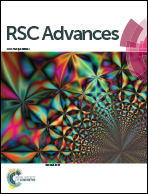Highly efficient synthesis of carbon nanocoils on alumina spheres
Abstract
Carbon nanocoils (CNCs) and carbon nanotubes (CNTs) can be selectively synthesized on the surfaces of alumina spheres using an Fe2(SO4)3/SnCl2 catalyst with different molar ratios of Fe to Sn by a thermal chemical vapor deposition method. On increasing the catalyst concentration, the average coil diameter, fiber diameter and pitch of the CNCs are increased. Furthermore, different productivities of CNCs can be obtained on the alumina spheres with diameters of 2 mm, 1 mm and 500 μm. It is discovered that on decreasing the diameter of alumina spheres, the thickness of the carbon layer is also decreased, resulting in a negative effect on the yield of the CNCs. A high yield of CNCs grown on 500 μm alumina spheres can be achieved by increasing the catalyst concentration to improve the thickness of the carbon layer.


 Please wait while we load your content...
Please wait while we load your content...